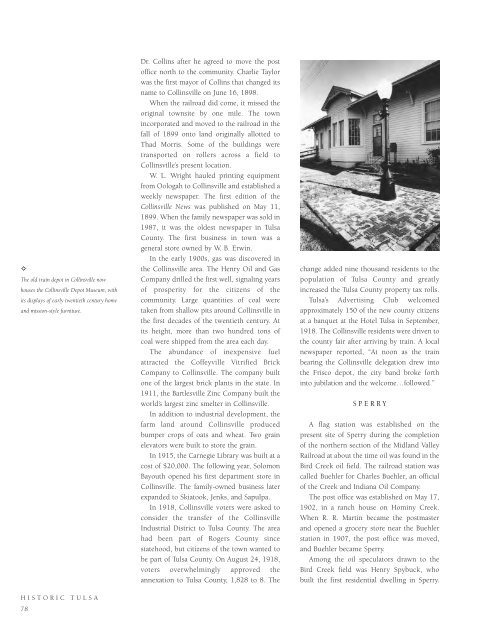Historic Tulsa
An illustrated history of the city of Tulsa, Oklahoma, paired with the histories of companies, families and organizations that make the region great.
An illustrated history of the city of Tulsa, Oklahoma, paired with the histories of companies, families and organizations that make the region great.
Create successful ePaper yourself
Turn your PDF publications into a flip-book with our unique Google optimized e-Paper software.
✧<br />
The old train depot in Collinsville now<br />
houses the Collinsville Depot Museum, with<br />
its displays of early twentieth century home<br />
and mission-style furniture.<br />
HISTORIC TULSA<br />
78<br />
Dr. Collins after he agreed to move the post<br />
office north to the community. Charlie Taylor<br />
was the first mayor of Collins that changed its<br />
name to Collinsville on June 16, 1898.<br />
When the railroad did come, it missed the<br />
original townsite by one mile. The town<br />
incorporated and moved to the railroad in the<br />
fall of 1899 onto land originally allotted to<br />
Thad Morris. Some of the buildings were<br />
transported on rollers across a field to<br />
Collinsville’s present location.<br />
W. L. Wright hauled printing equipment<br />
from Oologah to Collinsville and established a<br />
weekly newspaper. The first edition of the<br />
Collinsville News was published on May 11,<br />
1899. When the family newspaper was sold in<br />
1987, it was the oldest newspaper in <strong>Tulsa</strong><br />
County. The first business in town was a<br />
general store owned by W. B. Erwin.<br />
In the early 1900s, gas was discovered in<br />
the Collinsville area. The Henry Oil and Gas<br />
Company drilled the first well, signaling years<br />
of prosperity for the citizens of the<br />
community. Large quantities of coal were<br />
taken from shallow pits around Collinsville in<br />
the first decades of the twentieth century. At<br />
its height, more than two hundred tons of<br />
coal were shipped from the area each day.<br />
The abundance of inexpensive fuel<br />
attracted the Coffeyville Vitrified Brick<br />
Company to Collinsville. The company built<br />
one of the largest brick plants in the state. In<br />
1911, the Bartlesville Zinc Company built the<br />
world’s largest zinc smelter in Collinsville.<br />
In addition to industrial development, the<br />
farm land around Collinsville produced<br />
bumper crops of oats and wheat. Two grain<br />
elevators were built to store the grain.<br />
In 1915, the Carnegie Library was built at a<br />
cost of $20,000. The following year, Solomon<br />
Bayouth opened his first department store in<br />
Collinsville. The family-owned business later<br />
expanded to Skiatook, Jenks, and Sapulpa.<br />
In 1918, Collinsville voters were asked to<br />
consider the transfer of the Collinsville<br />
Industrial District to <strong>Tulsa</strong> County. The area<br />
had been part of Rogers County since<br />
statehood, but citizens of the town wanted to<br />
be part of <strong>Tulsa</strong> County. On August 24, 1918,<br />
voters overwhelmingly approved the<br />
annexation to <strong>Tulsa</strong> County, 1,828 to 8. The<br />
change added nine thousand residents to the<br />
population of <strong>Tulsa</strong> County and greatly<br />
increased the <strong>Tulsa</strong> County property tax rolls.<br />
<strong>Tulsa</strong>’s Advertising Club welcomed<br />
approximately 150 of the new county citizens<br />
at a banquet at the Hotel <strong>Tulsa</strong> in September,<br />
1918. The Collinsville residents were driven to<br />
the county fair after arriving by train. A local<br />
newspaper reported, “At noon as the train<br />
bearing the Collinsville delegation drew into<br />
the Frisco depot, the city band broke forth<br />
into jubilation and the welcome…followed.”<br />
SPERRY<br />
A flag station was established on the<br />
present site of Sperry during the completion<br />
of the northern section of the Midland Valley<br />
Railroad at about the time oil was found in the<br />
Bird Creek oil field. The railroad station was<br />
called Buehler for Charles Buehler, an official<br />
of the Creek and Indiana Oil Company.<br />
The post office was established on May 17,<br />
1902, in a ranch house on Hominy Creek.<br />
When R. R. Martin became the postmaster<br />
and opened a grocery store near the Buehler<br />
station in 1907, the post office was moved,<br />
and Buehler became Sperry.<br />
Among the oil speculators drawn to the<br />
Bird Creek field was Henry Spybuck, who<br />
built the first residential dwelling in Sperry.
















